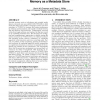Free Online Productivity Tools
i2Speak
i2Symbol
i2OCR
iTex2Img
iWeb2Print
iWeb2Shot
i2Type
iPdf2Split
iPdf2Merge
i2Bopomofo
i2Arabic
i2Style
i2Image
i2PDF
iLatex2Rtf
Sci2ools
EMSOFT
2006
Springer
2006
Springer
Reliability mechanisms for file systems using non-volatile memory as a metadata store
Portable systems such as cell phones and portable media players commonly use non-volatile RAM (NVRAM) to hold all of their data and metadata, and larger systems can store metadata in NVRAM to increase file system performance by reducing synchronization and transfer overhead between disk and memory data structures. Unfortunately, wayward writes from buggy software and random bit flips may result in an unreliable persistent store. We introduce two orthogonal and complementary approaches to reliably storing file system structures in NVRAM. First, we reinforce hardware and operating system memory consistency by employing page-level write protection and error correcting codes. Second, we perform on-line consistency checking of the filesystem structures by replaying logged file system transactions on copied data structures; a structure is consistent if the replayed copy matches its live counterpart. Our experiments show that the protection mechanisms can increase fault tolerance by six orde...
| Added | 22 Aug 2010 |
| Updated | 22 Aug 2010 |
| Type | Conference |
| Year | 2006 |
| Where | EMSOFT |
| Authors | Kevin M. Greenan, Ethan L. Miller |
Comments (0)

